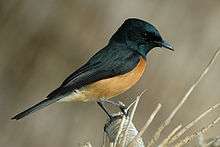Vanikoro flycatcher
| Vanikoro flycatcher | |
|---|---|
 | |
| male | |
| Scientific classification | |
| Kingdom: | Animalia |
| Phylum: | Chordata |
| Class: | Aves |
| Order: | Passeriformes |
| Family: | Monarchidae |
| Genus: | Myiagra |
| Species: | M. vanikorensis |
| Binomial name | |
| Myiagra vanikorensis (Quoy & Gaimard, 1830) | |
| Subspecies | |
|
See text | |
The Vanikoro flycatcher (Myiagra vanikorensis) is a species of monarch flycatcher in the family Monarchidae. It has a slightly disjunct distribution, occurring in Santa Cruz Islands (or Vanikoro, hence its common and specific name) in the southern Solomon Islands and the islands of Fiji. It is closely related to the insular Melanesian flycatcher, Samoan flycatcher, Makira flycatcher and Solomon flycatcher, as well as the Australian leaden flycatcher.
Taxonomy and systematics
Five subspecies are recognized:[2]
- M. v. vanikorensis - (Quoy & Gaimard, 1830): Found on Vanikoro (eastern Solomon Islands)
- M. v. rufiventris - Elliot, DG, 1859: Found on northern, central and southern Fiji
- M. v. kandavensis - Mayr, 1933: Found on Beqa, Vatulele and Kadavu Island (south-western Fiji)
- M. v. dorsalis - Mayr, 1933: Found on northern Lau Islands and the Moala Islands (eastern Fiji)
- M. v. townsendi - Wetmore, 1919: Found on southern Lau Islands (south-eastern Fiji)
Description
The Vanikoro flycatcher is a small passerine, 13 cm long and weighing around 13 g. It has a large, slightly hooked black bill and black legs. The plumage varies between the sexes; the male has dark blue-black plumage over the head and throat, back, tail and wings, and a washed out red belly with a white rump. The pattern for the female is similar, but paler overall (orange instead of red, slate grey instead of dark blue) and with the orange of the belly also coming up the throat as far as the bill. There is some variation based on subspecies; the female of the race dorsalis of the northern Lau Group has a white throat, whereas the male of kandavensis has much richer orange underparts. The juvenile birds resemble females but also have white scalloping on the wings.
Distribution and habitat
.jpg)
The Vanikoro flycatcher is capable of living in a wide variety of habitats. It naturally occurs in forest and forest edge habitats from sea level up to 1100 m, but has also adapted to living in disturbed human altered habitats, including gardens and cultivated areas, so long as a few trees survive. The species is insectivorous, taking a variety of insects by sallying from perches and snatching them in the air or from the undersides of leaves. In addition to insects Vanikoro flycatchers will also eat lizards and small fruits. Individuals, pairs or even small groups forage in the canopy in undisturbed forest but will use other areas in disturbed areas; they will forage around buildings are highly inquisitive.
Behaviour and ecology
In Fiji the Vanikoro flycatcher breeds from September to February. The nest is a small cup of plant fibres, grass stems and roots, decorated on the outside with lichen and leaves and lined with animal hair. The nest is placed high in a tree on a horizontal branch. nest construction is undertaken by both sexes, as in incubation and chick rearing. The clutch of pinkish-white freckled eggs usually numbers 1-2. Predators, like the Fiji goshawk and the local race of the peregrine falcon, are aggressively mobbed.
Status
The Vanikoro flycatcher is not considered threatened by the IUCN, and is listed as least Concern. It remains common across most of Fiji, and is tolerant of human changes to the environment.
References
- ↑ BirdLife International (2012). "Myiagra vanikorensis". IUCN Red List of Threatened Species. Version 2013.2. International Union for Conservation of Nature. Retrieved 26 November 2013.
- ↑ "IOC World Bird List 6.4". IOC World Bird List Datasets. doi:10.14344/ioc.ml.6.4.
- del Hoyo, J.; Elliot, A. & Christie D. (editors). (2006). Handbook of the Birds of the World. Volume 11: Old World Flycatchers to Old World Warblers. Lynx Edicions. ISBN 84-96553-06-X.

